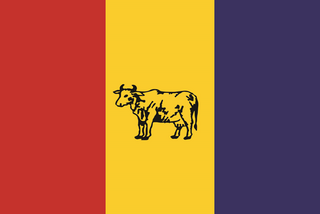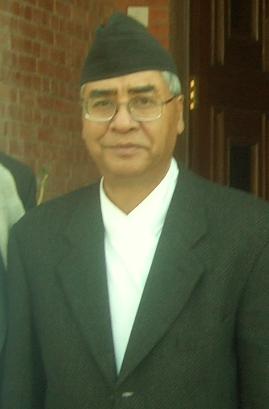
Surya Bahadur Thapa was a Nepali politician and a five-time Prime Minister of Nepal. He served under three different kings in a political career lasting more than 50 years.

The Rastriya Prajatantra Party is a constitutional monarchist and Hindu nationalist political party in Nepal.
The fourth Chand cabinet was formed on 11 October 2002 after Lokendra Bahadur Chand was appointed as prime minister by King Gyanendra, The cabinet only had representatives from two political parties of the dissolved House of Representatives. The cabinet was expanded on 18 November 2002. The cabinet was reshuffled in 11 April 2003.

Kamal Thapa is a Nepalese politician belonging to Rastriya Prajatantra Party Nepal.

The Rastriya Panchayat was the legislature of the Kingdom of Nepal from during the panchayat era from 1962 to 1990. Following the 1960 coup by King Mahendra, the enactment of the Constitution of 1962, made the Rastriya Panchayat the supreme legislative body in the country, replacing the Parliament of Nepal.

The Madhav Kumar Nepal cabinet was formed on 23 May 2009 after Madhav Kumar Nepal of the CPN (UML) was appointed as prime minister. His candidacy was supported by twenty of twenty five parties in the 1st Constituent Assembly. He took office with a three member cabinet on 25 May 2009. Eight ministers were added from Nepali Congress and MJFN (Loktantrik) on 4 June.

The Second Oli cabinet, also known as the Oli cabinet, 2018, was the Government of Nepal from 15 February 2018 to 13 July 2021. It initially formed as a majority coalition on 15 February 2018, after Khadga Prasad Sharma Oli was elected as the new Prime Minister of Nepal following the 2017 general election. Oli's candidacy was supported by the Communist Party of Nepal and the Communist Party of Nepal. He assumed his office with two ministers and the remaining ministers were added at later points. The CPN withdrew its support from the government in May 2021, reducing it to a minority, and after the dissolution of the House of Representatives, it turned into an interim government. The cabinet was replaced by the fifth Deuba cabinet, formed after the Supreme Court ordered the appointment of Nepali Congress president Sher Bahadur Deuba as prime minister under Article 76 (5) of the Constitution of Nepal.
The first Girija Prasad Koirala cabinet was formed on 26 May 1991 when Girija Prasad Koirala was appointed as prime minister by King Birendra following the 1991 election. The council of ministers was recommended by Koirala and were appointed on 29 May 1991. The cabinet was expanded with the appointment of two state ministers on 5 May 1991.

The first Sher Bahadur Deuba cabinet was formed on 12 September 1995. After Man Mohan Adhikari lost support in the House of Representatives, he recommended to dissolve the lower house. However, the Supreme Court restored the lower house and King Birendra appointed Nepali Congress parliamentary party leader Sher Bahadur Deuba as prime minister on 11 September 1995. He was supported by the Rastriya Prajatantra Party and Nepal Sadbhawana Party.

The Chand–Gautam coalition was formed on 12 March 1997, after the biggest party in the House of Representatives, CPN (UML) supported Rastriya Prajatantra Party leader Lokendra Bahadur Chand as the prime minister. The cabinet was expanded on 25 March 1997, 30 June 1997 and 29 August 1997.
The fourth Surya Bahadur Thapa cabinet was formed on 7 October 1997. Surya Bahadur Thapa of the Rastriya Prajatantra Party was appointed as the prime minister by King Birendra after he was supported by Nepali Congress, Nepal Sadbhawana Party and some independents. The cabinet was expanded on 27 October 1997 and was reshuffled on 3 December 1997.
The second Girija Prasad Koirala cabinet was formed on 15 April 1998 after the appointment of Nepali Congress leader Girija Prasad Koirala as prime minister by King Birendra. Girja was supported by CPN (Marxist–Leninist). The cabinet was expanded on 21 April 1998. On 26 August 1998, the cabinet was reshuffled and ministers from CPN (Marxist–Leninist) where included. After CPN (Marxist–Leninist) withdrew their support for the government on 11 December 1998, Girija resigned as prime minister ten days later.

The Krishna Prasad Bhattarai cabinet was formed on 31 May 1999 after Nepali Congress leader Krishna Prasad Bhattarai was appointed as the prime minister by King Birendra following the 1999 election. The cabinet was reshuffled on 30 June 1999.
The fourth Girija Prasad Koirala cabinet was formed on 21 March 2000 after Nepali Congress leader Girija Prasad Koirala was appointed as the prime minister by King Birendra. After the His Majesty's Government Regulations 2000 came into effect on 18 April 2000, the cabinet was reformed. The cabinet was reshuffled on 7 February 2001.
The second Deuba cabinet was formed on 26 July 2001 after Nepali Congress leader Sher Bahadur Deuba was appointed as prime minister by King Gyanendra. The cabinet was expanded on 18 October 2001.
The third Deuba cabinet of Nepal was formed on 10 June 2004 after the appointment of Sher Bahadur Deuba as prime minister by King Gyanendra. The cabinet was expanded on 5 July 2004 with the inclusion of CPN (UML), Rastriya Prajatantra Party and Nepal Sadbhawana Party.
The fifth Girija Prasad Koirala cabinet was formed on 29 April 2006 after Girija Prasad Koirala was appointed prime minister following the 2006 revolution. The cabinet was expanded on 22 May 2006 and again on 11 June 2006. The cabinet signed the Comprehensive Peace Accord with the CPN (Maoist).
The Girija Prasad Koirala interim cabinet was formed on 1 April 2007. The interim cabinet was formed as a national unity government which included the former Maoist rebels.










